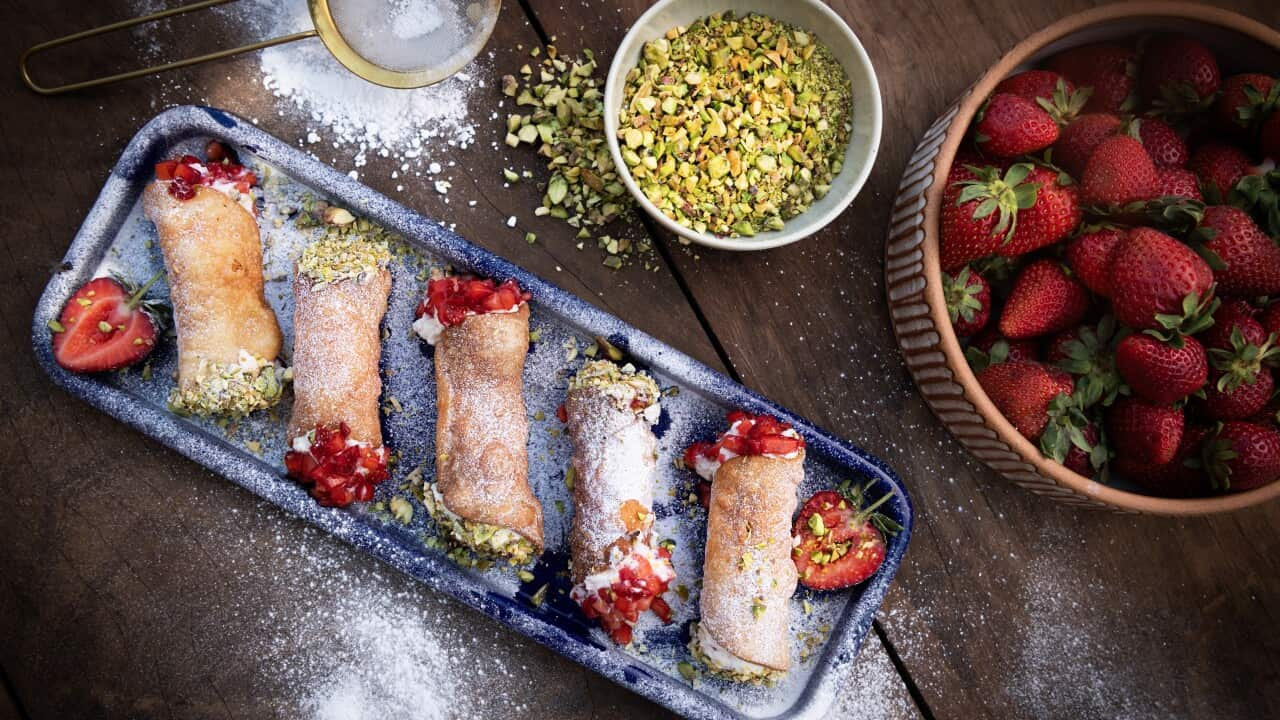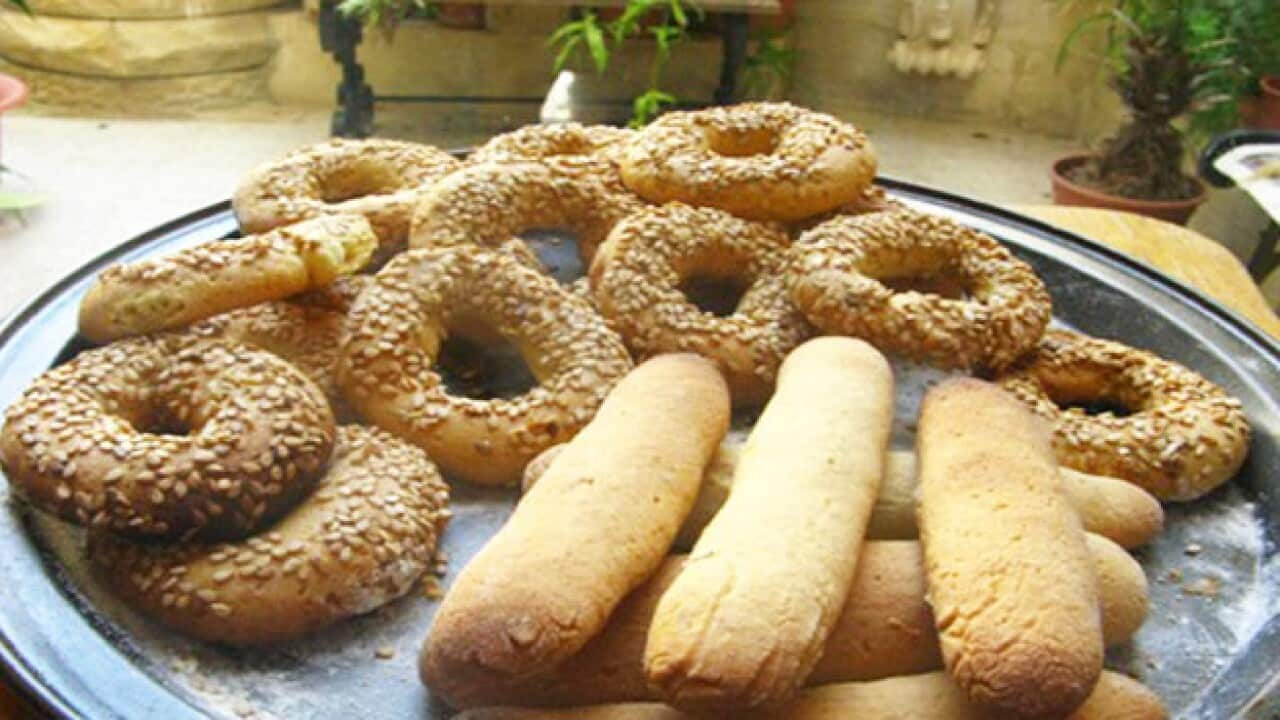— Ainsley Harriott hits the road again and this time his travels take him to beautiful Malta, a cultural mash-up of Sicilian, British, Spanish and even French culture. The cuisine and tradition offer a rich territory for Ainsley to explore. . —
Stream free On Demand

Ainsley's Taste of Malta
series • cooking
PG
series • cooking
PG
I feel peaceful contentment and genetic pining for sweetened ricotta, served in a deep-fried bow-shaped shell, as I think about Maltese kannoli (kannoli ta' l-irkotta).
I can’t separate the thought or taste of the traditional Maltese sweet from the memory of my late mother: a Maltese immigrant who made Australia her home in 1968. Nor do I need or want to. Kannoli, intentionally spelt with a k, was ‘her’ dish and every time I eat it, I can feel her presence. In kannoli, I take comfort.
Alongside other Maltese dessert favourites that serenade the country’s multicultural influences (from bread and butter pudding to imqaret), kannoli exists as an identifiable part of the nation’s food culture.
The Italian variety of cannoli that Maltese kannoli most resembles is Sicilian. Both have a bow shape, are deep-fried and are traditionally made with ricotta from sheep’s milk.
There are, however, a few differences between the Sicilian and Maltese desserts. Sicilian dough uses marsala or white wine while Maltese kannoli uses red wine. Sicilian shells may also feature sugar, eggs and vinegar, while the Maltese variety does not. But upon looking at a Sicilian cannoli and Maltese kannoli, you’d be hard-pressed to notice many visual variations.
Kannoli was ‘her’ dish and every time I eat it – whether it’s spelt with a k or c – I can feel her presence. In kannoli, I take comfort.
The sweet, Maltese-Sicilian connection
So how did Maltese kannoli come to be? As it turns out, all varieties of cannoli can be traced back to Sicily, between 827 and 1091 AD.
from 870 AD. In 1130 AD, the Normans unified Sicily’s islands, Malta and parts of North Africa as the . Malta remained part of Sicily until 1530. So it’s easy to understand how Sicilian cannoli gave rise to Maltese kannoli.
These days, ricotta kannoli featuring chocolate, nuts and candied peel are sold at most cafes, pasticcerias and bakeries across the Maltese archipelago, especially throughout the capital of Valetta. They’re also sold by street vendors at festas and are rolled out at family gatherings.
recently commented on the widespread popularity of kannoli in Malta today, after he visited the islands for the. SBS series,
“Not only are there cultural influences in the food, but also the people; it’s a real melting pot,” . “I think [Malta is reflective of] the modern world that we’re living in now,” he explains. “You know? Everything fits and it’s just really lovely.”
The chef and TV host even made his version of the traditional Maltese dessert, . Ainsley’s recipe adds mascarpone to the ricotta filling for a touch of sweetness.
Whether or not you stick to a more traditional filling of pure ricotta or make it Ainsley's way, you can rest assured that the crunchy shell of a Maltese kannoli cast against its sweet, cheesy filling will taste sensational.
A cultural gift: the art of kannoli eating
One of the gifts I received as a child of a Maltese mother was a delicious education on how to eat kannoli. Mum's rules, as I inherited them, were: don’t bother eating kannoli that’s made with anything but ricotta – it’s not traditional; the filling should always be made with full-fat ricotta as that low-fat stuff won’t have the same taste; only eat kannoli that’s been stuffed a few minutes before serving, otherwise, they’ll turn soggy and a kannoli will always taste better if it's dusted with icing sugar.
...We mustn’t be turned off making kannoli because we don’t have a deep-fryer. If you’ve got a wok, use that instead.
As a parting gift, one month before my mum died, she taught my husband and I how to make Maltese kannoli. Even though cancer had stolen most of her energy, she somehow fathomed enough spirit to deliver one last food offering in this world. She told us there was no need to fuss about a piping bag if we didn’t have one – use a teaspoon to fill the shells and enjoy. Also, we mustn’t be turned off making kannoli because we didn’t have a deep-fryer. If you’ve got a wok, use that to cook the shells instead.
Most importantly, she said, taste as you go. Food is all about pleasure in the now.

Mary Noone (middle) taught her daughter and son-in-law to make Maltese kannoli.
Kannoli can connect
When I think of Maltese kannoli today, I remember the proud photo we took in my mother’s kitchen after we learned to make her red wine shells, deep-fried in her dated wok. My mind zooms in on her smile. She’s full of joy and I can feel her in my heart.
Only in her absence do I now realise what kannoli – and other traditional dishes – meant to Maltese immigrants living in Australia. When you can’t eat with a loved one because they’ve died or are living abroad, cultural food can facilitate an impossible connection. Through the experience of cooking and eating, distances may be eliminated and, if only for a moment, death can feel as though it's no longer.
When you can’t eat with a loved one because they’ve died or are living abroad, cultural food can facilitate an impossible connection.
My kannoli memory brings my mother back to me. It transports me to her kitchen and I watch her eat the Maltese treat with joy.
‘It is beautiful’, I can hear her saying in her thick accent. For a few seconds, the matriarch in my mind is at peace, united with the native flavours and textures that once felt natural to her.
I open my eyes and the memory fades.
I think it’s time to return to making kannoli again.









